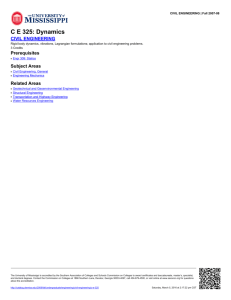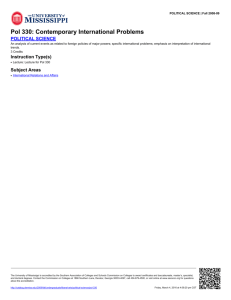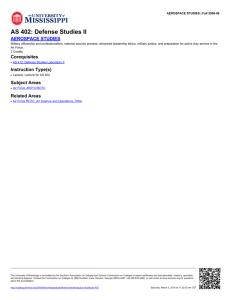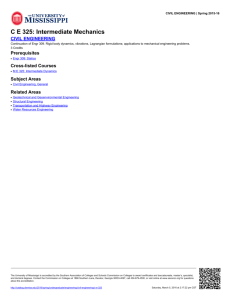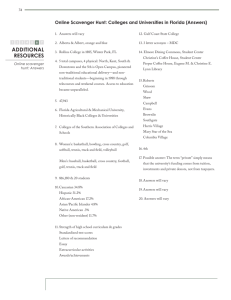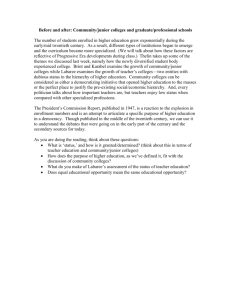The City University of New York Overview of CUNY Operating
advertisement
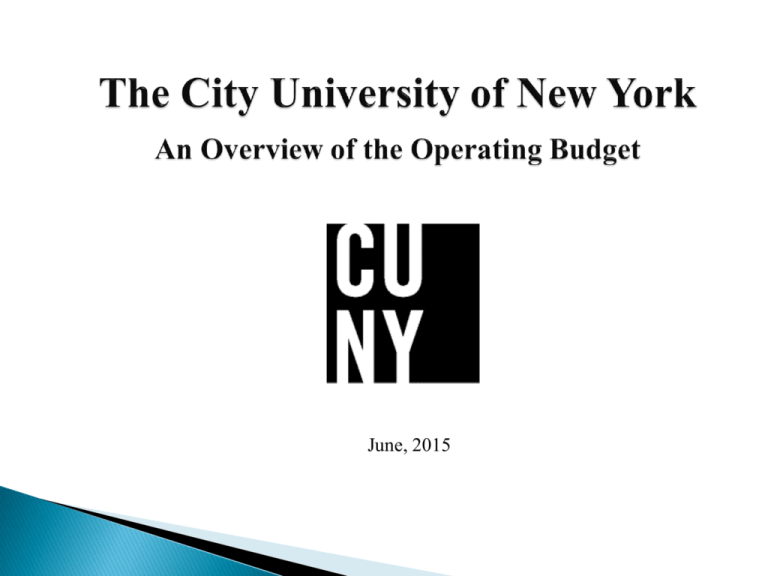
June, 2015 The Process 1 New York State provides funding for the senior colleges using line item appropriations. It includes line items for each senior college, Central Administration, and various University programs. Funding comes from state aid and tuition revenue. New York City provides a lump sum budget for the University by units of appropriation in its adopted budget. CUNY’s budget is comprised of four major components. These are College base budgets, which are appropriated to the colleges and expended locally; Central Administration; the funding of Fringe Benefits, Energy, Building Rental, and student financial aid costs; and University-wide programs, which are lump sum appropriations that are largely allocated to the colleges via formulae. Colleges receive an initial allocation of their annual budgets at the beginning of the academic year. Subsequent allocations are made during the year to adjust for revenue collections and to disburse additional funds. 2 The State Budget for the senior colleges includes $175 million in appropriation for special revenue accounts, including the Income Fund Reimbursable Account (IFR), the City University Tuition Reimbursement Account (CUTRA), and the City University Stabilization Account. ◦ The IFR is made up mostly of self-supporting adult and continuing education programs. Colleges can spend what they collect. The IFR programs, however, are subject to an 12.0% cost recovery target. ◦ The CUTRA account enables the colleges to roll over into subsequent fiscal years excess tuition revenue. It gives colleges the ability to plan better for the use of additional revenue and, in effect, grants the colleges additional appropriation authority albeit limited due to the non-recurring nature of these resources. ◦ The Stabilization account enables the colleges and University to carry-over into subsequent fiscal years unexpended tax levy appropriations. Current annual expenditure level is limited to $10 million. 3 The City’s budget includes funding for Associate Degree programs at the College of Staten Island, New York City College of Technology, and Medgar Evers College. Funding is also provided for a share of the costs of University Management, and an amount for its pre-financing of senior college operations. The City’s budget also includes an amount for Hunter Campus Schools, which are run by Hunter College. The City and State Adopted budgets also include legislative member initiatives for specific items or activities at the colleges. 4 The University submits an operating tax-levy budget request to the State and the City that is comprised of both the mandatory, or base-line needs, and the programmatic request. ◦ The mandatory request includes contractual salary increases and other than personal service (OTPS) inflationary increases. It also includes requests for rent increases, fringe benefits, energy, and new building needs. ◦ The programmatic request is based on University Program initiatives outlined in the Master Plan and is developed by the University’s central leadership in consultation with various CUNY constituencies, including members of the Board of Trustees, College Presidents, and faculty and student representatives. 5 The CUNY Compact is the University’s vehicle for financing its Master Plan. The Compact calls for the leveraging of resources from the key stakeholders: ◦ The State and City, which are asked to contribute 100% of mandatory costs, plus a portion of the Investment Program. ◦ Friends of the colleges, through an unprecedented focus on philanthropy. ◦ The University, through continuing its drive toward greater efficiencies, restructuring and improved productivity. ◦ The Students, through continued targeted enrollment growth and predictable tuition increases that do not exceed the rate of inflation. 6 July - October Call letter from Chancellor to College Presidents College Presidents submit college priorities for consideration by University University consults with faculty and student governance organizations regarding groups’ budget priorities and concerns University prepares draft overview of Request and consults with Council of Presidents and Board Committee on Fiscal Affairs November – December January – March April - June Draft Budget Request is presented to the Board of Trustees Fiscal Affairs committee for review and consideration State releases Executive Budget Recommendations April 1 is State deadline for budget adoption City releases Financial Plan and Preliminary Budget April 26 is deadline for release of City Executive Budget recommendations Board hearing is held on draft Request Testimony on impact of NYS Executive Budget recommendations before NYS Senate Finance and Assembly Ways and Means Committees Full Board considers Budget Request Board-approved Budget Request is formally transmitted to City and State Executive branches for consideration Testimony on impact of NYC Financial Plan and Preliminary Budget before NYC Council Finance and Higher Education Committees and Borough Presidents Testimony on impact of NYC Executive Budget before NYC Council Finance and Higher Education Committees June 5 is deadline for adoption of City Budget 7 Senior college budget allocations are issued in May following the adoption of the State budget. Community College allocations are issued in July following the adoption of the City budget. The allocation processes for the senior and community colleges differ significantly. At the senior colleges, incremental budgeting is used. The community college process is twofold and includes a zero-based enrollment-driven model and an incremental budgeting component. Both the senior and community colleges also receive lump sum allocations for University wide programs. Senior College, University Management and Compact Allocations ◦ The senior college allocation starts with the base budget for each college and University Management. This is followed by the allocation of various lump sum appropriations. Additional allocations for University initiatives and other miscellaneous items are added throughout the year. ◦ Items that are paid for centrally, such as fringe benefits, building rentals, and student financial aid, are not allocated to the colleges but expended centrally on their behalf. 8 Lump sum allocations: These include child care, collaborative programs with the NYC Dept. of Education, Coordinated Undergraduate Education, language immersion programs, SEEK, and services for the disabled. Throughout the year, the colleges may receive additional allocations for various miscellaneous items. Programmatic Lump Sums The majority of these (child care, services for students with disabilities, collaborative programs, College Now, coordinated undergraduate education, SEEK, etc.) are determined by the Office of Academic Affairs and Office of Student Affairs and are based on existing or planned activities at the colleges. 9 Colleges receive an allocation that is determined by the community college allocation model, and incremental budget, plus lump sum amounts, the majority of which are determined by the Office of Academic Affairs. While the model determines 100% of the funding needs at the colleges, the actual allocation that the colleges receive is discounted, because the overall appropriation is not sufficient to fund all priorities and 100% of the model. The community college allocation model is zero-based and predicated on an enrollmentdriven budget model. It incorporates a 3-year weighted average of enrollment to develop the allocation for the following functions: teaching, instructional support, and base and per FTE funding for library, student services, general administration, and general institutional services. Teaching needs are determined using the instructional staff model, which generates these needs according to enrollment and student faculty ratios by discipline. Allocations for plant maintenance and operations, continuing education, and student aid are driven by college specific criterion. Prior year Compact funding is added incrementally each year. 10 The tuition revenue budget is appropriated by the State to the senior colleges as a lump sum and by the City to the community colleges as part of the overall budget. Because tuition revenue represents a component of each college's budget, it is critical that colleges collect revenue at or above their established targets, in order for the University to expend its total budgetary appropriation. 11 Once the allocations are issued, colleges are required to submit financial plans detailing the projected uses of their funds. The financial plan includes a Compact spending plan that details the use of Compact funds. Compact Investment Plans must be developed in consultation with elected faculty and student representatives. It also includes a hiring plan showing annual changes in full-time positions by function. 12 The Numbers 13 The 2014-2015 tax-levy operating budget for the City University totals $3.1 billion. Tuition revenue and the State of New York are the principal funding sources of the University, financing 45.0% each of the cost of operating the system. The City of New York finances the remaining 10.0% of the cost of operating the City University. 14 Senior and Community College Funding and Percent by Source ($ in millions) FY2015 Adopted Percentage Senior Colleges State Aid $1,200.1 53% $32.3 1% $1,025.6 45% $2,258.0 100% State Aid $225.0 27% City Support $271.7 32% Tuition & Other Revenue $350.8 41% Total Community Colleges $847.5 100% $1,425.1 46% $304.0 10% $1,376.4 44% $3,105.5 100% City Support Tuition & Other Revenue Total Senior Colleges¹ Community Colleges University-wide State Aid City Support Tuition & Other Revenue Total University 15 16 17 FY2014 Fringe Benefits Expenditures ($000) Senior Colleges Community Colleges Workers Faculty Welfare Compensation Employee $34,628 $3,342 Welfare 7% 1% $15,205 3% Unemployment Insurance $1,941 0% Pension $175,017 35% Social Security $87,490 18% Faculty Welfare MTA Payroll Workers $12,854 Compensation Tax Impact Employee 7% $1,689 $2,088 Welfare 1% 1% $7,532 4% Unemployment Insurance $986 0% Pension $63,557 32% Social Security $36,084 18% Health $178,118 36% Total Senior Colleges: $495,741 Health $72,713 37% Total Community Colleges: $197,504 18 FY2014 Energy Expenditures ($000) Senior Colleges Water and Sewer $6,168 Steam 7% Community Colleges Fuel Oil $3,305 4% Water and Sewer $3,187 11% $4,381 5% Fuel Oil $1,434 5% Steam $2,446 8% Natural gas expenses $12,398 15% Electricity expenses $58,744 69% Total Senior Colleges: $84,997 Natural gas expenses $4,013 13% Electricity expenses $18,889 63% Total Community Colleges: $29,969 19 Colleges have invested $44 million in academic programs and support, including $17 million for 160 new faculty. $15.1 million supported facility and infrastructure improvements. This includes enhancements to the activities needed to operate a college. $34 million was dedicated to student financial aid. $15 million is being used for student services, such as support for students with disabilities, veterans' services and career services. 20 ► The University dedicated 10 million from the revenue generated by the tuition increase to assist students whose matriculation was at risk because of the increase: • $6.6 million – senior colleges • $3.4 million - community colleges. ► The University-wide Student Financial Assistance Initiative includes the following: • • • • Acquisition of text books - $3.0 million Federal work-study program enhancements - $ 2.7 million Tuition waivers - $4.0 million Veterans’ support services - $0.3 million 21 Senior Colleges ► The FY2016 state adopted budget for the senior colleges totals $2.336 billion, an increase of $77.9 million, or 3.5 percent, over the current year. • $12.0 million for completion of college performance improvement plans. • $3.9 million for SEEK. • $0.5 million for CUNY LEADS. • $0.5 million for the Joseph S. Murphy Institute. • $0.25 million for the graduate pipeline program at the Graduate Center. 22 Senior Colleges (con’t) • $60.8 million in revenue appropriations to accommodate the $300 annual tuition increase to resident undergraduate tuition and proportionate increases to all other tuition categories. Of this amount, $8.4 million is associated with TAP waivers for tuition above the maximum TAP award of $5,165. • The enacted budget does not provide any funding for mandatory needs totaling $51 million. 23 Community Colleges State Adopted Budget ► The FY2016 state enacted budget provides $234.2 million for the community colleges, an increase of $9.2 million from the FY2015 level. Per FTE student base aid is increased by $100 to generate an additional $8.3 million. Enrollment reductions offset this amount by $2.2 million. ASAP funding is $2.5 million, a $0.8 million increase over the FY2015 level. Child care funding is increased by $0.4 million. College Discovery funding is increased by $0.2 million. $1.0 million is provided for community schools grants. $0.75 million is provided for One Stop Job Centers at the community colleges. 24 Community Colleges (con’t) City Executive Budget The city executive budget provides $286.5 million for the community colleges, a net increase of $14.8 million from the FY2015 level. ► • CUNY Start Math Expansion - $1.5 million • Metro cards for students at Guttman Community College - $1.0 million • Expand Fatherhood Academy to additional community colleges - $1.0 million • Pension/fringe benefit increase - $5.5 million • Energy reduction – ($0.7) million • STEM Support Expansion - $10.3 million (from FY2015 executive budget). • Efficiency savings total $3.8 million and include $2.0 million in energy savings and $1.8 million in college specific initiatives. • The revenue appropriation is increased by $24.2 million to accommodate the $300 tuition increase for fall 2015. 25 University-wide Funding by Source ($ millions) FY2015 Adopted FY2016 State Enacted/City Exec Change from base $ Change from base % Senior Colleges State Aid $1,200.1 $1,217.2 $17.1 1.4% $32.3 $32.3 $0.0 0.0% $1,025.6 $1,086.4 $60.8 5.9% $2,258.0 $2,335.9 $77.9 3.5% State Aid $225.0 $234.2 $9.2 4.1% City Support $271.7 $285.2 $13.5 5.0% Tuition & Other Revenue $350.8 $375.0 $24.2 6.9% Total Community Colleges $847.5 $894.4 $46.9 5.5% $1,425.1 $1,451.4 $26.3 1.8% $304.0 $317.5 $13.5 4.4% $1,376.4 $1,461.4 $85.0 6.2% $3,105.5 $3,230.3 $124.8 4.0% City Support Tuition & Other Revenue Total Senior Colleges¹ Community Colleges University-wide State Aid City Support Tuition & Other Revenue Total University 26 Q&A 27
